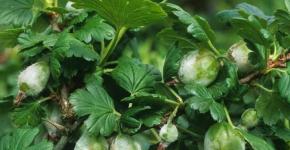Iron vitriol: a method of use in gardening in the fall
One of the most popular means of pest control is ferrous sulfate; the use of this agent in gardening in autumn is no less active than in spring.
Iron vitriol has a crystalline appearance, not transparent, odorless, in chemistry it is defined as ferrous sulfate or ferrous sulfate. With it, you can improve the condition of old trees, as well as increase the fertility of young ones. Usually used diluted in water, but different types of plants need a different concentration.
Gardeners often use ferrous sulfate because it is not only effective, but affordable. It is actively used to combat:
- insect pests;
- mosses, rot, lichens;
- infection on the surface and in the hollows of trees;
- lack of iron;
- fungal plant diseases.
Iron vitriol finds its application not only in gardening, but also in construction as an additional antiseptic agent when processing wood from fungus, rot and mold.
It should be noted that ferrous sulfate has an increased acidity, when it gets on the leaves, it leaves burns, so it should be used for treating trees and shrubs in autumn and spring, when the leaves have not yet appeared or when they have already fallen off. Most often, it is at this time that fungal foci appear, the reason for this is plant residues on the surface of plants, as well as the soil around them. In this case, not only trees, but also the soil are treated with a solution.
Iron sulfate is also used as whitewashing of plant trunks in preventive and disinfection measures. To do this, it is necessary to dilute 100 g of ferrous sulfate in 1 liter of pure water.
Concentration of solutions
There is no single instruction for breeding ferrous sulfate. Experienced gardeners distinguish between different concentrations of solution for different types of plants:
- For stone fruit crops such as apricot, peach, clay, plum, sweet cherry, cherry, you need to make a 3% solution. Method of preparation: Dissolve 300 g of ferrous sulfate in 10 liters of water. Spray bare branches and trunk before the onset of cold weather. Process the vine in front of the shelter.
- For fruit pome crops such as grapes, apple trees, pears, a 4% concentrate is prepared. Method of preparation: dilute 300 g of ferrous sulfate in 10 liters of water.
- For these types of horticultural crops, it is possible to use a 5-6 percent solution. Method of preparation: according to the same algorithm as mentioned above, it is only necessary to increase the amount of the product - dissolve 500-600 g in 10 liters of water.
Spraying with iron sulfate from harmful insects is carried out with a 5% solution, it is better to carry out the procedure in late autumn. This will help get rid of insects that hibernate in the bark of trees.
For spraying against moss and lichen rot, a 3 percent solution is used for stone fruit species, and a 5 percent solution for pome plants.
Trees are treated with iron sulfate in the autumn as a preventive measure with a 1% solution (100 - 150 g of powder per 10-15 liters of water). It is useful to spray damaged areas of plants with such a concentrate.

Iron vitriol is used as tree feeding in case of iron deficiency in the soil both in autumn and spring. Chlorosis of young leaves is considered a sign of iron deficiency, while the old ones retain their color. Owners of grapes, apple trees, plums, and raspberries most often face the increased sensitivity of crops to iron deficiency. To feed the plants, it is necessary to dilute 50 g of ferrous sulfate in 10 liters of water, process the trunk and soil every 4-5 days until the leaves appear green.
This substance is capable of delaying bud opening, if the treatment is carried out with a 3-6 percent solution, the delay lasts about 7-10 days. This feature can be used during spring frosts.
The following disadvantages of this substance are distinguished:
- ferrous sulfate is not effective in combating bacterial plant diseases;
- when fighting pests and fungi, it is useless in low concentrations (1 percent or less);
- the protective effect lasts up to 14 days.
Precautionary measures
Do not confuse ferrous sulfate with copper sulfate, which is more dangerous for the human body. Iron vitriol belongs to the third class of toxic substances, the substance is not flammable and not explosive. When working with iron sulfate, special protection of a person is not required, but care must be taken that the solution does not touch the mucous membranes of the eyes and mouth. If the concentrated solution gets on the skin, it should be immediately washed off with plenty of soap and water.


